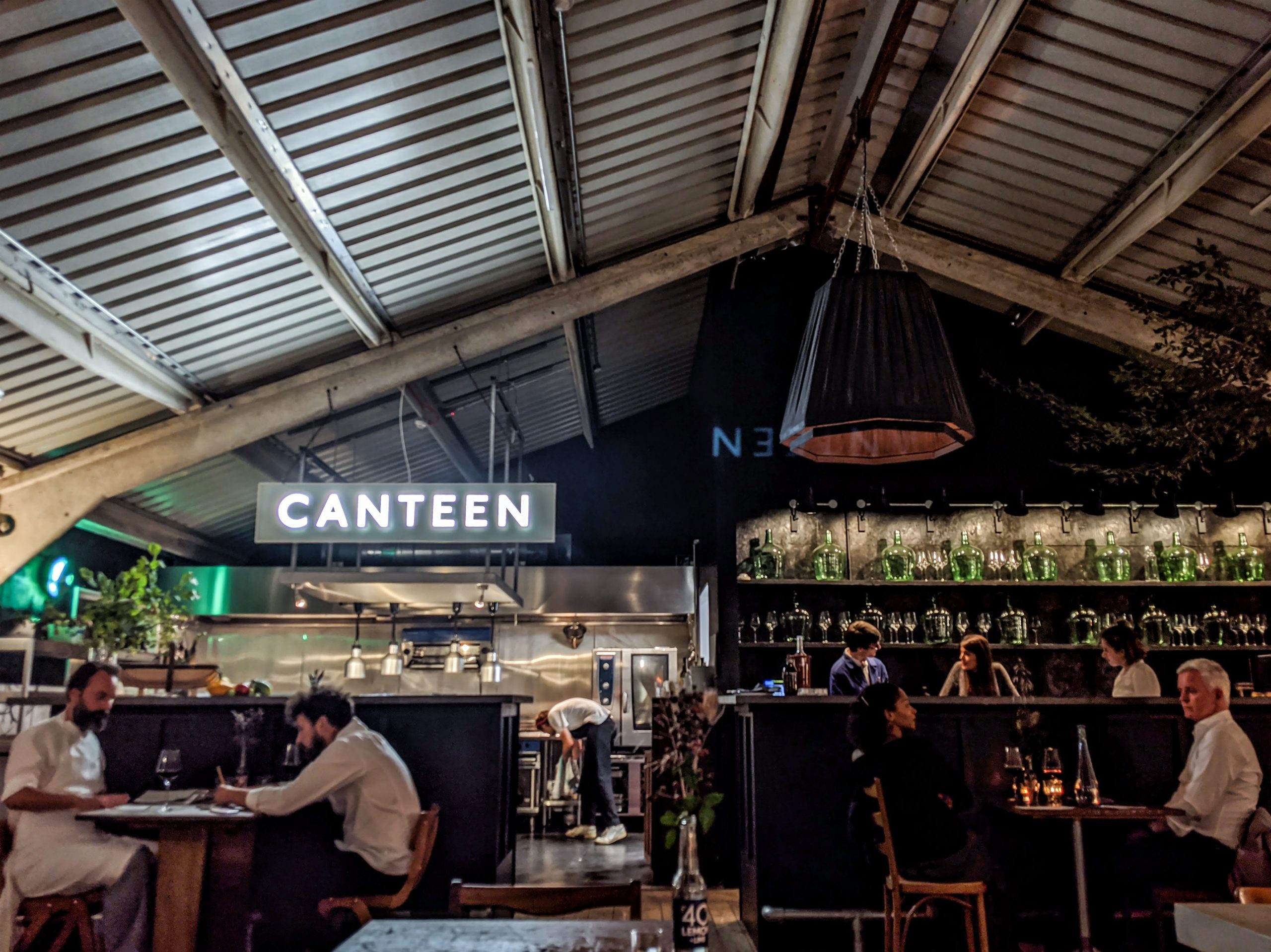
Listening to a summer shower pelt down on a tin roof, piping hot sourdough pizza slice in one hand and glass of slightly hazy English Sparkling Wine in the other, you can’t help but feel incredibly relaxed. Looking up at the towering, rusted roof of the Dutch barn above us, it wouldn’t be difficult to imagine that we’d trespassed onto a derelict farm, if it weren’t for the lights shining through the plate glass window of the tasting room opposite.
This is Tillingham in Peasmarsh, East Sussex, one of England’s many new wine estates that has sprouted across the South-East in the past few years. Despite an increasingly crowded field, Tillingham has distinguished itself as one of England’s most innovative producers. Their minimal intervention approach to winemaking and evocative labels have given them a strong following amongst Natural Wine lovers in London, Brighton and Bristol. It has also earned them a few raised eyebrows from more conservative members of the wine trade.
It has been a busy year at Tillingham. When we visited, in late August, they were bottling the last of the 2019 vintage (made from grapes bought from local growers) and were getting ready to bring in the first harvest of the estate’s own fledging vines. Having been forced to close the brand-new restaurant, hotel and tasting room during the lockdowns, they re-opened their doors to guests this week.
Ben Walgate, Tillingham’s co-founder, explained the approach taken by Tillingham: the estate practises organic farming, eschewing the use of artificial herbicides and fungicides. He also borrows elements of the biodynamic approach, employing plant-based remedies to promote the health of his vines. Of course, in a wet climate like England’s, the threat of mildew is ever-present, and the limited use of copper and sulfur-based sprays cannot be avoided. The aim of this ‘melting pot’ of modern science and traditional techniques is to restore and maintain the health and biodiversity of the land on which Tillingham sits, explains Ben.
You won’t just find vines at Tillingham. Animals play an important role too. 35 acres of the farm are set aside for grazing sheep; they also keep pigs and cows. When we arrive, Ben suggests a helpful rendezvous point “by the goats”, which are responsible for the mozzarella that tops the farm’s pizzas. Ben points out that the leftover whey can actually be used to fight the mildew in the vineyard. While polyculture and animal husbandry are important aspects of biodynamics, it also reflects the farming heritage of the area.
This heritage is also present in Tillingham’s striking architecture. The sparkling winery, full of tanks and barrels of all shapes, sizes and materials, sits opposite a Victorian farmhouse and derelict oast house. Walking further down the brushed concrete pathway brings you to the looming Dutch barn where you can enjoy stone-baked pizzas.
But it is the bar and restaurant that steal the show. Constructed out of the side of a drab farm shed, the tasting room’s polished concrete floors and muted lighting draw you in. The restaurant, located upstairs, and sitting under a vaulted metal shed roof, feels cavernous. It really is unlike any winery I have ever been to.

Welcoming visitors was always part of the plan, explains Ben. It provided the opportunity to demonstrate Tillingham’s unique approach to winemaking and spread word-of-mouth. “I saw it as the best way to get the business off the ground.” Socially-distanced tours offer visitors the chance to learn more about organic viticulture, regenerative farming, and minimal intervention winemaking.
Whilst many British wineries offer visitors a chance to learn about winemaking, Tillingham’s unique approach offers something different. As we munched on pizza under the Dutch barn, we spotted Ben leading a group to the farm’s oast house, home to several Georgian clay amphora called qvevri. These vessels play an important role in helping to mature Tillingham’s wine and are only found in a handful of wineries in the UK.
Tillingham’s restaurant offers a locally sourced set menu to work your way through while gazing out over the vines. “My love of hospitality and food made me want to give people a full experience”, says Walgate. Despite tighter restrictions, the restaurant’s spaciousness allows it to seat 35 people and maintain the buzz of a bustling eatery while maintaining social distance.
The menu is unpretentious and reasonably priced, and is served by staff who are knowledgeable and friendly. You can enjoy your meal with Tillingham’s own wines or choose from a selection of others from outside of England. For me, the temptation of a wine pairing proved too strong. I wasn’t let down. Tillingham’s lightly-sparkling ‘Col’ was followed by a delightful Mâcon-Villages, then an unusual Cot (Malbec) from Loire and, finally, a sweet Jurançon.
Part of Tillingham’s appeal is what it offers those who aren’t certified wine geeks. You won’t find any of the pretentiousness associated with wine here. Aside from the tours and tasting room, Tillingham offers the chance to bask in the quiet isolation of this corner of East Sussex, away from the stress and anxieties of the Christmas season.
You can make a stay of it too. There are eleven rooms in all, each comfy and decorated in a modern, understated manner. Plans are already underway to expand capacity with the addition of bell tents for those who want to get up close and personal with the vines.
Wine tourism will play a crucial role for English vineyards in the years to come. With cellar door sales a crucial source of revenue and tours providing an opportunity to improve consumer awareness of English Wine, investment in welcoming visitors is a good bet for producers, new and old. Even in the past two years, there has been a noticeable shift in attitudes toward English Wine. As Ben points out, visiting your local vineyard is now recognised as something the English countryside has to offer.
I am confident in saying that Tillingham offers a peek into English wine’s future. We’ve been making world-class wine for quite a while; now it’s time to build world-class wineries to go with them.
Tillingham is located 10-minutes from Rye, Sussex. It can be accessed by taking the train from St Pancras, via Ashford International (1.5hrs), or by car (2hrs from central London). For bookings and more information, visit www.tillingham.com
Tillingham ‘Col’ 2018
Grapes: Pinot Noir, Chardonnay & Pinot Meunier
63% Pinot Noir, 32% Chardonnay, 5% Pinot Meunier. Fruit from Kent and East Sussex. Gently fizzy and fairly hazy with aromas of rich, baked red apples and shortcrust pastry.
It’s made using the Italian ‘Col Fondo’ method which involves secondary fermentation in the bottle but leaves the wine undisgorged. That means no dosage; while the wine is fresh, it achieves a good amount of softness on the palate. A lovely, slightly alternative take on classic English Sparkling Wine.
Tillingham ‘White’ 2019
Grapes: Diverse White Blend
An alphabet soup of grapes: 55% Müller-Thurgau, 21% Bacchus, 8% Sauvignon Blanc, 8% Madeleine Angevine, 6% Chardonnay and 2% Auxerrois. Half of the Müller-Thurgau undergoes extended skin-contact.
There are flavours of green apple, fresh pears and just a touch of citrus. Fresh, light-bodied, and just 9% ABV, but somehow delightfully textured.
Tillingham Pinot Blanc 2019
Grapes: Pinot Blanc
This is made from 100% Pinot Blanc, a grape mostly found in Alsace. It is the most common variety used in Crémant d’Alsace (sparkling wine), however it is increasingly being grown in England for both still and sparkling wines.
Two-thirds of this (still) wine is fermented in old oak barrels and the remainder in qvevri. There are pronounced aromas of zesty lime, complemented by a touch of elderflower. It’s just as textured as the Tillingham white and, despite a little extra heft, remains wonderfully fresh.








Pingback: This Week's Latest Wine Headlines: November 27—December 4 - Briscoe Bites
“the estate practises organic farming”. Tillingham isn’t registered as organic (or biodynamic) as far as I am aware and out of respect for those that are, perhaps you should say so?
Hi Stephen,
Tillingham have been practicing biodynamic since 2017 and were recently certified by Demeter!
Sam